Process for preparing cyclic carbonates
Bayarmagnai , et al. April 5, 2
U.S. patent number 11,292,780 [Application Number 16/634,255] was granted by the patent office on 2022-04-05 for process for preparing cyclic carbonates. This patent grant is currently assigned to BASF SE. The grantee listed for this patent is BASF SE. Invention is credited to Bilguun Bayarmagnai, Verena Mormul, Peter Rudolf, Thomas Schaub.












View All Diagrams
| United States Patent | 11,292,780 |
| Bayarmagnai , et al. | April 5, 2022 |
Process for preparing cyclic carbonates
Abstract
The present invention relates to a process for preparing cyclic carbonates of formula Ia or Ib or mixtures thereof (Ia) (Ib) comprising the process step: a) reacting a propargylic alcohol of formula II (II) with carbon dioxide in the presence of at least one transition metal catalyst TMC1, which comprises a transition metal selected from metals of groups 10, 11 and 12 of the periodic table of the elements according to IUPAC and at least one bulky ligand. ##STR00001##
| Inventors: | Bayarmagnai; Bilguun (Heidelberg, DE), Schaub; Thomas (Ludwigshafen, DE), Mormul; Verena (Ludwigshafen, DE), Rudolf; Peter (Ludwigshafen, DE) | ||||||||||
|---|---|---|---|---|---|---|---|---|---|---|---|
| Applicant: |
|
||||||||||
| Assignee: | BASF SE (Ludwigshafen am Rhein,
DE) |
||||||||||
| Family ID: | 59626515 | ||||||||||
| Appl. No.: | 16/634,255 | ||||||||||
| Filed: | August 14, 2018 | ||||||||||
| PCT Filed: | August 14, 2018 | ||||||||||
| PCT No.: | PCT/EP2018/072014 | ||||||||||
| 371(c)(1),(2),(4) Date: | January 27, 2020 | ||||||||||
| PCT Pub. No.: | WO2019/034648 | ||||||||||
| PCT Pub. Date: | February 21, 2019 |
Prior Publication Data
| Document Identifier | Publication Date | |
|---|---|---|
| US 20200369640 A1 | Nov 26, 2020 | |
Foreign Application Priority Data
| Aug 14, 2017 [EP] | 17186136 | |||
| Current U.S. Class: | 1/1 |
| Current CPC Class: | H01M 10/0567 (20130101); B01J 31/2282 (20130101); C07D 317/40 (20130101); C08F 124/00 (20130101); Y02E 60/10 (20130101); H01M 2300/0025 (20130101) |
| Current International Class: | C07D 317/40 (20060101); B01J 31/22 (20060101); H01M 10/0567 (20100101); C08F 124/00 (20060101) |
| Field of Search: | ;549/296,295 |
References Cited [Referenced By]
U.S. Patent Documents
| 6639114 | October 2003 | Ahlers et al. |
| 10604500 | March 2020 | Licht et al. |
| 2013/0059178 | March 2013 | Ihara et al. |
| WO 2011/157671 | Dec 2011 | WO | |||
Other References
|
Tang, X. et al.: Polystyrene-supported N-heterocyclic Carbene-silver complexes as robust and efficient catalysts for the reaction of Carbon dioxide and propargylic alcohols. Adv. Synthesis & Catalysis, vol. 355, pp. 2019-2028, 2013. cited by examiner . International Preliminary Report on Patentability dated Feb. 18, 2020 in PCT/EP2018/072014 filed Aug. 14, 2018, 6 pages. cited by applicant . Andrea Buzas, et al., "Gold(I)-Catalyzed Formation of 5-Methylene-1,3-oxazolidin-2-ones", Synlett, vol. 17, 2006, pp. 2727-2730. cited by applicant . Nicola Della CA, et al., "Effective Guanidine-Catalyzed Synthesis of Carbonate and Carbamate Derivatives from Propargyl Alcohols in Supercritical Carbon Dioxide" Advanced Synthesis and Catalysis, vol. 353, Issue 1, Jan. 20, 2011, pp. 133-146. cited by applicant . Pierre De Fremont, et al., "Carbenes: Synthesis, Properties, and Organometallic Chemistry" Coordination Chemistry Reviews, vol. 253, 2009, pp. 862-892. cited by applicant . Yoshio Inoue, et al., "Cobaltocene-Catalyzed Reaction of Carbon Dioxide with Propargyl Alcohols" Bulletin of the Chemical Society of Japan, vol. 60, Issue 3, Mar. 1987, pp. 1204-1206. cited by applicant . Hak-Soo Kim, et al., "Catalytic Formation of Carbamates and Cyclic Carbonates by Copper Complex of 2,5,19,22-tetraaza[6,6](1,1')ferrocenophane-1,5-diene X-ray Crystal Structure of [Cu(1)]PF6" Journal of Organometallic Chemistry, vol. 545-546, 1997, pp. 337-344. cited by applicant . David V. Partyka, et al., "Facile Synthesis of (Phosphine)- and (N-heterocyclic Carbene) Gold(I) and Silver(I) Azide Complexes" Organometallics, vol. 28, Issue 3, Jan. 6, 2009, pp. 795-801. cited by applicant . Barry M. Trost, et al., "Synthesis of 4-Methylene-1,3-Dioxolan-2-one, a Bifunctional Cyclic Carbonate" Journal of Organic Chemistry, vol. 48, Issue 19, Sep. 1, 1983, pp. 3346-3347. cited by applicant . Wataru Yamada, et al., "Silver-Catalyzed Incorporation of Carbon Dioxide into Propargylic Alcohols" European Journal of Organic Chemistry, vol. 2007, Issue 16, May 10, 2007, pp. 2604-2607. cited by applicant . Hirofumi Yamamoto, et al., "Hg(OTf)2-Catalyzed Cyclization of alkynyl tert-butylcarbonate Leading to Cyclic Enol Carbonate" Tetrahedron Letters, vol. 47, Issue 47, Nov. 20, 2006, pp. 8369-8373. cited by applicant . International Search Report dated Sep. 24, 2018 in PCT/EP2018/072014 filed on Aug. 14, 2018, 3 pages. cited by applicant . Buzas et al., "Gold-catalyzed rearrangement of propargylic tert-butyl carbonates," Elsevier, Tetrahedron, vol. 65, No. 9, 2009, pp. 1889-1901, DOI: 10.1016/j.tet.2008.11.108, XP055135539. cited by applicant . Qi. et al., "Efficient Synthesis of .beta.-Oxoalkyl Carbamates from Carbon Dioxide, Internal Propargylic Alcohols, and Secondary Amines Catalyzed by Silver Salts and DBU," Synthesis, No. 9, 2010, pp. 1433-1440, DOI: 10.1055/s-0029-1218675, XP-002775643. cited by applicant. |
Primary Examiner: Aulakh; Charanjit
Attorney, Agent or Firm: Gruneberg and Myers PLLC
Claims
The invention claimed is:
1. A process for preparing a cyclic carbonate of formula Ia or Ib or a mixture thereof ##STR00045## wherein R.sup.1 is hydrogen or an organic radical having from 1 to 40 carbon atoms, the process comprising: a) reacting a propargylic alcohol of formula II ##STR00046## wherein R.sup.1 is defined as in formula Ia or Ib, with carbon dioxide in the presence of at least one transition metal catalyst TMC1, which comprises: a transition metal selected from metals of groups 10, 11 and 12 of the periodic table of the elements; and at least one bulky ligand selected from the group of ligands consisting of a compound of formula III and a compound of formula IV ##STR00047## wherein D is P, As or Sb, R.sup.2, R.sup.3, R.sup.4 and R.sup.5 are each independently an organic radical having from 1 to 40 carbon atoms, and Z is a divalent bridging group selected from --CR.sup.7.dbd.CR.sup.8--, --CR.sup.7.dbd.N--, --CR.sup.7R.sup.9-- CR.sup.8R.sup.10-- and --CR.sup.7R.sup.9--CR.sup.8R.sup.10--CR.sup.11R.sup.12--, wherein R.sup.7, R.sup.8, R.sup.9, R.sup.10, R.sup.11 and R.sup.12 are each independently hydrogen or an organic radical having from 1 to 40 carbon atoms or two adjacent radicals R.sup.7 and R.sup.8 and/or R.sup.10 and R.sup.11 together with the atoms connecting them form a monocyclic or polycyclic, substituted or un-substituted, aliphatic or aromatic ring system which has from 4 to 40 carbon atoms and optionally comprises at least one heteroatom selected from the group of elements consisting of Si, Ge, N, P, O and S thereby obtaining the cyclic carbonate of formula Ia or Ib or the mixture thereof in a yield of from 2% to 99%.
2. The process of claim 1, wherein R.sup.1 is hydrogen, hydroxymethyl (--CH.sub.2OH), acetoxy-methylene (--CH.sub.2OC(O)CH.sub.3), formyloxy-methylene (--CH.sub.2OC(O)H) or --CH.sub.2OC(O)OCH.sub.3.
3. The process of claim 1, wherein the transition metal of the at least one transition metal catalyst TMC1 is Ag.
4. The process of claim 1, wherein the at least one transition metal catalyst TMC1 is prepared in situ by using a transition metal compound, which does not comprise any bulky ligand, and the compound of formula III or the compound of formula IV as a bulky ligand or a protonated form of the compound of formula IV represented by formula V, ##STR00048## wherein R.sup.2, R.sup.5 and Z are defined as in formulae III or IV and X.sup.- is an anion equivalent, together with a base.
5. The process of claim 4, wherein the transition metal compound is selected from AgOAc, AgF, Ag.sub.2O and Ag.sub.2CO.sub.3.
6. The process of claim 1, wherein the at least one bulky ligand is a compound of formula III.
7. The process of claim 1, wherein the at least one bulky ligand is selected from a compound of the following formulae A to P and mixtures thereof ##STR00049## ##STR00050## ##STR00051##
8. The process of claim 1, wherein a molar ratio of the at least one bulky ligand to the transition metal of the at least one transition metal catalyst TMC1 is in a range of from 0.4 to 1.2.
9. The process of claim 1, wherein an amount of the at least one transition metal catalyst TMC1 used in a) is in a range of from 0.005 to 5 mol %, based on an amount of the propargylic alcohol of formula II.
10. The process of claim 1, wherein a) is performed at a pressure in a range of from 1 to 50 bar.
11. The process of claim 1, wherein a) is performed at a temperature in a range of from 0.degree. C. to 1.degree. *C.
12. The process of claim 1, wherein a) is carried out in the presence of a solvent selected from the group consisting of aliphatic hydrocarbons, aromatic hydrocarbons, halogenated hydrocarbons, amides, ureas, nitriles, sulfoxides, sulfones, esters, carbonates, ethers, alcohols and mixtures thereof.
13. The process of claim 1, wherein the cyclic carbonate of formula Ia or Ib or the mixture thereof is separated from the at least one transition metal catalyst TMC1 after a) via distillation.
14. The process of claim 1, wherein the the at least one transition metal catalyst TMC1 is recycled to the reacting of a) after the cyclic carbonate of formula Ia or Ib or the mixture thereof is removed via distillation.
15. A process for preparing a cyclic carbonate of formula Ia or Ib or a mixture thereof ##STR00052## wherein R.sup.1 is hydrogen or an organic radical having from 1 to 40 carbon atoms, the process comprising: a) reacting a propargylic alcohol of formula II ##STR00053## wherein R.sup.1 is defined as in formula Ia or Ib, with carbon dioxide in the presence of at least one transition metal catalyst TMC1, which comprises: a transition metal selected from metals of groups 10, 11 and 12 of the periodic table of the elements; and at least one bulky ligand selected from the group of ligands consisting of a compound of formula III and a compound of formula IV ##STR00054## wherein D is P, As or Sb, R.sup.2, R.sup.3, R.sup.4 and R.sup.5 are each independently an organic radical having from 1 to 40 carbon atoms, and Z is a divalent bridging group selected from --CR.sup.7.dbd.CR.sup.8--, --CR.sup.7.dbd.N--, --CR.sup.7R.sup.9-- CR.sup.8R.sup.10-- and --CR.sup.7R.sup.9--CR.sup.8R.sup.10--CR.sup.11R.sup.12--, wherein R.sup.7, R.sup.8, R.sup.9, R.sup.10, R.sup.11 and R.sup.12 are each independently hydrogen or an organic radical having from 1 to 40 carbon atoms or two adjacent radicals R.sup.7 and R.sup.8 and/or R.sup.10 and R.sup.11 together with the atoms connecting them form a monocyclic or polycyclic, substituted or un-substituted, aliphatic or aromatic ring system which has from 4 to 40 carbon atoms and optionally comprises at least one heteroatom selected from the group of elements consisting of Si, Ge, N, P, O and S, wherein the at least one transition metal catalyst TMC1 is prepared in situ by using a transition metal compound, which does not comprise any bulky ligand, and the compound of formula III or the compound of formula IV as a bulky ligand or a protonated form of the compound of formula IV represented by formula V, ##STR00055## wherein R.sup.2, R.sup.5 and Z are defined as in formulae III or IV and X.sup.- is an anion equivalent, together with a base.
16. A process for preparing a cyclic carbonate of formula Ia or Ib or a mixture thereof ##STR00056## wherein R.sup.1 is hydrogen or an organic radical having from 1 to 40 carbon atoms, the process comprising: a) reacting a propargylic alcohol of formula II ##STR00057## wherein R.sup.1 is defined as in formula Ia or Ib, with carbon dioxide in the presence of at least one transition metal catalyst TMC1, which comprises: a transition metal selected from metals of groups 10, 11 and 12 of the periodic table of the elements; and at least one bulky ligand of formula III ##STR00058## wherein D is P, As or Sb, and R.sup.2, R.sup.3, and R.sup.4 are each independently an organic radical having from 1 to 40 carbon atoms.
Description
The present invention relates to a process for preparing cyclic carbonates of formula Ia or Ib or mixtures thereof
##STR00002##
comprising the process step:
a) reacting a propargylic alcohol of formula II
##STR00003## with carbon dioxide in the presence of at least one transition metal catalyst TMC1, which comprises a transition metal selected from metals of groups 10, 11 and 12 of the periodic table of the elements according to IUPAC and at least one bulky ligand.
Exo-vinylene carbonates are valuable compounds, especially for the use in electrolytes for batteries as described in US 2013/0059178 A1 or as monomers in polymer applications as described in WO 2011/157671 A1. Exo-Vinylene carbonates with substituents in the 4,4-position are available via the reaction of secondary or tertiary propargylic alcohols with CO.sub.2 using different catalysts like metals or bases.
##STR00004##
None of the protocols, which are described in the literature, like the Silver-, Copper-, Cobalt- or guanidine catalyzed cyclisations could until now be applied to the conversion of simple primary propargylic alcohols with CO.sub.2 towards the simple Exo-vinylene carbonates with two hydrogens in the 4,4-positions.
In Eur. J Org. Chem. 2007, 2604-2607 the silver-catalyzed incorporation of carbon dioxide into propargylic alcohol is reported, where AgOAc in combination with DBU is the catalyst system. This catalyst system worked well for the cyclisation of tertiary propargylic alcohols, but the method was not applicable to primary or secondary propargylic alcohols for their conversion into the corresponding cyclic products.
In Journal of Organometallic Chemistry, 1997, 545-546, 337-344, a Cu-catalyzed cyclisation of propargylic alcohols with CO.sub.2 is reported. The copper catalyst, which comprised a tetradentate imine ligand was used in combination with different amine bases. These catalysts worked well for the cyclisation of tertiary propargylic alcohols, but no cyclisation product was formed from primary propargylic alcohol.
In the attempts for the guanidine-catalyzed cyclisation of propargylic alcohols with CO.sub.2 reported in Advanced Synthesis and Catalysis, 2011, 353, 133-146, no metal catalyst was added. These catalysts worked well for the cyclisation of tertiary- and secondary propargylic alcohols, but no Exo-vinylenecarbonate from primary propargylic alcohol was formed under these conditions.
In the attempts for the Cobalt-catalyzed cyclisation of propargylic alcohols with CO.sub.2 reported in Bulletin of the Chemical Society of Japan, 1987, 60, 1204-1206, PPh.sub.3 was added as the donor ligand in combination with NEt.sub.3 as the base. This catalyst worked well for the cyclisation of tertiary propargylic alcohols, but no Exo-vinylene carbonate from primary propargylic alcohol was formed under these conditions.
In the prior art, the only reasonable synthetic approach to the 4-methylene-1,3-dioxolan-2-one, the simplest Exo-vinylene carbonate, is the Gold- or Mercury catalyzed cyclisation of propargylic tert-butylcarbonates which is described in Synlett, 2006, 17, 2727-2730 and in Tetrahedron Letters, 2006, 47, 8369-8373.
##STR00005##
One disadvantage of this route is, that the propargylic tert-butylcarbonate must be prepared first from propargylic alcohol and the relatively expensive BOC-anhydride.
Another disadvantage of the cyclisation of the propargylic tert-butlycarboante is, that the other tBu group is released as Isobutene and therefore a byproduct is formed, which must be disposed or recycled.
Another route towards 4-methylene-1,3-dioxolan-2-one is described in J. Org. Chem. 1983, 48(19), 3346-3347. This method starts from a chlorinated glycerol derivative and uses PhSeNa as reagent. This route does not allow commercial production of the product.
Accordingly, it is an object of the invention to provide a more economic process for preparing cyclic carbonates from primary propargylic alcohols and CO.sub.2, preferably directly from primary propargylic alcohols and CO.sub.2.
This object is achieved by a process for preparing cyclic carbonates of formula Ia or Ib or mixtures thereof
##STR00006##
wherein
R.sup.1 is hydrogen or an organic radical having from 1 to 40 carbon atoms,
comprising the process step:
a) reacting a propargylic alcohol of formula II
##STR00007## wherein R.sup.1 has the same meaning as in formula Ia or Ib, with carbon dioxide in the presence of at least one transition metal catalyst TMC1, which comprises a transition metal selected from metals of groups 10, 11 and 12 of the periodic table of the elements according to IUPAC, preferably selected from Cu, Ag and Au, more preferably Ag, and at least one bulky ligand selected from the group of ligands consisting of compounds of formula III and compounds of formula IV, preferably compounds of formula III,
##STR00008## wherein D is P, As or Sb, preferably P or As, in particular P, R.sup.2 is an organic radical having from 1 to 40 carbon atoms, preferably from 2 to 40 carbon atoms, preferably comprising at least one cyclic ring, more preferably, in formula III R.sup.2 is a C.sub.3 to C.sub.40 cycloalkyl radical, a C.sub.2 to C.sub.40 heterocycloalkyl radical, a C.sub.6 to C.sub.40 aryl radical, a C.sub.2 to C.sub.40 heteroaromatic radical, a C.sub.3 to C.sub.40 cycloalkoxy radical, a C.sub.2 to C.sub.40 heterocycloalkoxy radical, a C.sub.6 to C.sub.40 aryloxy radical or a C.sub.2 to C.sub.40 hetaryloxy radical, in particular a C.sub.6 to C.sub.40 aryl radical or a C.sub.2 to C.sub.40 heteroaromatic radical, R.sup.3, R.sup.4 are identical or different, and are each an organic radical having from 1 to 40 carbon atoms, and, R.sup.5 is an organic radical having from 1 to 40 carbon atoms or is identical to R.sup.2, and Z is a divalent bridging group selected from --CR.sup.7.dbd.CR.sup.8--, --CR.sup.7.dbd.N--, --CR.sup.7R.sup.9--CR.sup.8R.sup.10-- and --CR.sup.7R.sup.9--CR.sup.8R.sup.10--CR.sup.11R.sup.12--, wherein R.sup.7, R.sup.8, R.sup.9, R.sup.10, R.sup.11 and R.sup.12 are independently from each other hydrogen or as defined as R.sup.5 or two adjacent radicals R.sup.7 and R.sup.8 and/or R.sup.10 and R.sup.11 together with the atoms connecting them form a monocyclic or polycyclic, substituted or unsubstituted, aliphatic or aromatic ring system which has from 4 to 40 carbon atoms and can also comprise at least one heteroatom selected from the group consisting of the elements Si, Ge, N, P, O and S.
In one embodiment of the present invention, the inventive process is characterized in that D is P, R.sup.2 is a C.sub.3 to C.sub.40 cycloalkyl radical, a C.sub.2 to C.sub.40 heterocycloalkyl radical, a C.sub.6 to C.sub.40 aryl radical or a C.sub.2 to C.sub.40 heteroaromatic radical, preferably a C.sub.6 to C.sub.40 aryl radical or a C.sub.2 to C.sub.40 heteroaromatic radical, wherein R.sup.2 is substituted in at least one of the two ortho positions relative to P or N with a radical R.sup.6, which is an organic radical having from 1 to 40 carbon atoms, a halogen, in particular Cl or Br, hydroxy, SO.sub.3H or nitro or wherein R.sup.6 together with an adjacent radical substituting R.sup.2 in the meta position forms together with the atoms connecting them a monocyclic or polycyclic, substituted or unsubstituted, aliphatic or aromatic ring system, which has from 4 to 40 carbon atoms and can also comprise at least one heteroatom selected from the group consisting of the elements Si, Ge, N, P, O and S, preferably N and O, R.sup.3, R.sup.4, R.sup.5 and Z are defined as described above.
The substituents according to the present invention are, unless restricted further, defined as follows:
The term "organic radical having from 1 to 40 carbon atoms" as used in the present text refers to, for example, C.sub.1-C.sub.40-alkyl radicals, C.sub.1-C.sub.10-fluoroalkyl radicals, C.sub.1-C.sub.12-alkoxy radicals, saturated C.sub.3-C.sub.20-heterocyclic radicals, C.sub.6-C.sub.40-aryl radicals, C.sub.2-C.sub.40-heteroaromatic radicals, C.sub.6-C.sub.10-fluoroaryl radicals, C.sub.6-C.sub.10-aryloxy radicals, silyl radicals having from 3 to 24 carbon atoms, C.sub.2-C.sub.20-alkenyl radicals, C.sub.2-C.sub.20-alkynyl radicals, C.sub.7-C.sub.40-arylalkyl radicals or C.sub.8-C.sub.40-arylalkenyl radicals. An organic radical is in each case derived from an organic compound. Thus, the organic compound methanol can in principle give rise to three different organic radicals having one carbon atom, namely methyl (H.sub.3C--), methoxy (H.sub.3C--O--) and hydroxymethyl (HOC(H.sub.2)--). Therefore, the term "organic radical having from 1 to 40 carbon atoms" comprises beside alkoxy radicals for example also dialkylamino radicals, monoalkylamino radicals or alkylthio radicals.
In the present description, the term radical is used interchangeably with the term group, when defining the variables R.sup.x in the presented formulas.
The term "alkyl" as used in the present text encompasses linear or singly or multiply branched saturated hydrocarbons which can also be cyclic. Preference is given to a C.sub.1-C.sub.18-alkyl radical such as methyl, ethyl, n-propyl, n-butyl, n-pentyl, n-hexyl, n-heptyl, n-octyl, n-nonyl, n-decyl, cyclopentyl, cyclohexyl, isopropyl, isobutyl, isopentyl, isohexyl, sec-butyl or tert-butyl
The term "alkenyl" as used in the present text encompasses linear or singly or multiply branched hydrocarbons having one or more C--C double bonds which can be cumulated or alternating.
The term "saturated heterocyclic radical" as used in the present text refers to, for example, monocyclic or polycyclic, substituted or unsubstituted aliphatic or partially unsaturated hydrocarbon radicals in which one or more carbon atoms, CH groups and/or CH.sub.2 groups have been replaced by heteroatoms which are preferably selected from the group consisting of the elements O, S, N and P. Preferred examples of substituted or unsubstituted saturated heterocyclic radicals are pyrrolidinyl, imidazolidinyl, pyrazolidinyl, piperidyl, piperazinyl, morpholinyl, tetrahydrofuranyl, tetrahydropyranyl, tetrahydrothiophenyl and the like, and also methyl-, ethyl-, propyl-, isopropyl- and tert-butyl-substituted derivatives thereof.
The term "aryl" as used in the present text refers to, for example, aromatic and optionally fused polyaromatic hydrocarbon radicals which may be monosubstituted or polysubstituted by linear or branched C.sub.1-C.sub.18-alkyl, C.sub.1-C.sub.18-alkoxy, C.sub.2-C.sub.10-alkenyl or halogen, in particular fluorine. Preferred examples of substituted and unsubstituted aryl radicals are, in particular, phenyl, pentafluorophenyl, 4-methylphenyl, 4-ethylphenyl, 4-n-propylphenyl, 4-isopropylphenyl, 4-tert-butylphenyl, 4-methoxyphenyl, 1-naphthyl, 9-anthryl, 9-phenanthryl, 3,5-dimethylphenyl, 3,5-di-tert-butylphenyl or 4-trifluoromethylphenyl.
The term "heteroaromatic radical" as used in the present text refers to, for example, aromatic hydrocarbon radicals in which one or more carbon atoms or CH groups have been replaced by nitrogen, phosphorus, oxygen or sulfur atoms or combinations thereof. These may, like the aryl radicals, optionally be monosubstituted or polysubstituted by linear or branched C.sub.1-C.sub.18-alkyl, C.sub.2-C.sub.1-alkenyl or halogen, in particular fluorine. Preferred examples are furyl, thienyl, pyrrolyl, pyridyl, pyrazolyl, imidazolyl, oxazolyl, thiazolyl, pyrimidinyl, pyrazinyl and the like, and also methyl-, ethyl-, propyl-, isopropyl- and tert-butyl-substituted derivatives thereof.
The term "arylalkyl" as used in the present text refers to, for example, aryl-comprising substituents whose aryl radical is linked via an alkyl chain to the remainder of the molecule. Preferred examples are benzyl, substituted benzyl, phenethyl, substituted phenethyl and the like.
The terms fluoroalkyl and fluoroaryl mean that at least one hydrogen atom, preferably more than one and at most all hydrogen atoms, of the corresponding radical have been replaced by fluorine atoms. Examples of preferred fluorine-comprising radicals are trifluoromethyl, 2,2,2-trifluoroethyl, pentafluorophenyl, 4-trifluoromethylphenyl, 4-perfluoro-tert-butylphenyl and the like.
R.sup.1 in formulas Ia, Ib and II is hydrogen or an organic radical having from 1 to 40 carbon atoms, preferably hydrogen, acyclic or cyclic, substituted or unsubstituted C.sub.1-C.sub.10-alkyl, substituted or unsubstituted C.sub.6-C.sub.10-aryl or substituted or unsubstituted C.sub.7-C.sub.12-arylalkyl, in particular hydrogen or hydroxymethyl or a corresponding ester or carbonate thereof, in particular acetoxy-methylene (--CH.sub.2OC(O)CH.sub.3), formyloxy-methylene --CH.sub.2OC(O)H or --CH.sub.2OC(O)OCH.sub.3.
In one embodiment of the present invention, the inventive process is characterized in that R.sup.1 is hydrogen, hydroxymethyl (--CH.sub.2OH), acetoxy-methylene (--CH.sub.2OC(O)CH.sub.3), formyloxy-methylene (--CH.sub.2OC(O)H) or --CH.sub.2OC(O)OCH.sub.3.
For the avoidance of doubt, the term "propargylic alcohol of formula II" as used in the present description is not restricted to 2-Propyn-1-ol alone but it describes all compounds, which comprise the prop-2-yn-1-ol group.
##STR00009##
In the process of the invention, the propargylic alcohol of formula II is reacted with carbon dioxide in the presence of at least one transition metal catalyst TMC1. Transition metal catalyst TMC1 comprises a transition metal selected from metals of groups 10, 11 and 12 of the periodic table of the elements according to IUPAC, such as Ni, Pd, Pt, Cu, Ag, Au, Zn, Cd and Hg, preferably selected from Cu, Ag and Au, more preferably selected from Cu or Ag, in particular Ag.
In one embodiment of the present invention, the inventive process is characterized in that the transition metal of transition metal catalyst TMC1 is Ag
The transition metal catalyst TMC1 of the process of the invention can be employed in the form of a preformed metal complex which comprises a transition metal and at least one bulky ligand selected from the group of ligands consisting of compounds of formula III and compounds of formula IV, preferably compounds of formula III, as shown above. Alternatively, the transition metal catalyst TMC1 is formed in situ in the reaction medium by combining a metal compound, herein also termed pre-catalyst, which does not comprise any bulky ligand, with one or more suitable bulky ligand to form a catalytically active metal complex, the transition metal catalyst TMC1, in the reaction medium. In case the bulky ligand is a N-heterocyclic carbene ligand (NHC-ligand) of formula IV, it is also possible that the transition metal catalyst TMC1 is formed in situ in the reaction medium by combining a pre-catalyst with one or more NHC-precursor, in particular the protonated form of a NHC-ligand, which is in situ converted to the corresponding NHC-ligand of formula IV, to form a catalytically active metal complex in the reaction medium.
In one embodiment of the present invention, the inventive process is characterized in that the transition metal catalyst TMC1 is prepared in situ by using a transition metal compound, which does not comprise any bulky ligand, the compound of formula III or formula IV as bulky ligand or the protonated form of the compound of formula IV represented by formula V,
##STR00010##
wherein R.sup.2, R.sup.5 and Z are defined as described above and X.sup.- is an anion equivalent, together with a base.
Suitable bases for deprotonating the protonated form of different NHC ligands according to formula V are described by de Fremont et al., Coordination Chemistry Reviews 253 (2009) 876 to 881. The deprotonation of the protonated forms of NHC ligands can be carried out in ammonia or in non-protic solvents such as THF or ethers. The deprotonation requires anhydrous conditions and the use of strong bases, with pK.sub.a values above 14. Usually, potassium or sodium hydride with a catalytic amount of tert-butoxide is employed, but tert-butoxide itself, lithium aluminum hydride, n-butyllithium, MeLi, t-BuLi, potassium hexamethyldisilazide (KHMDS) and 1,8-diazabicyclo[5.4.0]undec-7-ene (DBU) are also efficient alternatives.
Suitable pre-catalysts are selected from neutral metal complexes, oxides and salts of metals of groups 10, 11 and 12 of the periodic table of the elements. Preferred pre-catalysts are selected from metal complexes, oxides and salts of copper, silver and gold, in particular silver.
Silver compounds that are useful as pre-catalyst are, for example Ag(OAc), AgF, AgNO.sub.3, silver trifluoroacetate, Ag.sub.2O, Ag.sub.2CO.sub.3.
In one embodiment of the present invention, the inventive process is characterized in that the transition metal compound, also called pre-catalyst, is selected from AgOAc, AgF, Ag.sub.2O and Ag.sub.2CO.sub.3.
In addition to the transition metal, the transition metal catalyst TMC1 comprises at least one bulky ligand selected from the group of ligands consisting of compounds of formula III and compounds of formula IV, preferably compounds of formula III.
##STR00011##
In case the bulky ligand is a compound of formula III,
##STR00012##
the variables are preferably defined as follows: D is P, As or Sb, preferably P or As, in particular P, R.sup.2 is an organic radical having from 1 to 40 carbon atoms, preferably from 2 to 40 carbon atoms, preferably comprising at least one cyclic ring, more preferably R.sup.2 is a C.sub.3 to C.sub.40 cycloalkyl radical, a C.sub.2 to C.sub.40 heterocycloalkyl radical, a C.sub.6 to C.sub.40 aryl radical, a C.sub.2 to C.sub.40 heteroaromatic radical, a C.sub.3 to C.sub.40 cycloalkoxy radical, a C.sub.2 to C.sub.40 heterocycloalkoxy radical, a C.sub.6 to C.sub.40 aryloxy radical, a C.sub.2 to C.sub.40 hetaryloxy radical, even more preferably R.sup.2 is a C.sub.3 to C.sub.40 cycloalkyl radical, a C.sub.2 to C.sub.40 heterocycloalkyl radical, a C.sub.6 to C.sub.40 aryl radical or a C.sub.2 to C.sub.40 heteroaromatic radical, preferably a C.sub.6 to C.sub.40 aryl radical or a C.sub.2 to C.sub.40 heteroaromatic radical, wherein R.sup.2 is substituted in at least one of the two ortho positions relative to D with a radical R.sup.6, which is an organic radical having from 1 to 40 carbon atoms, preferably a C.sub.6 to C.sub.40 aryl radical, a C.sub.1 to C.sub.10 alkoxy radical or a C.sub.2 to C.sub.12 dialkyl amino radical or wherein R.sup.6 together with an adjacent radical substituting R.sup.2 in the meta position forms together with the atoms connecting them a monocyclic or polycyclic, substituted or unsubstituted, aliphatic or aromatic ring system, which has from 4 to 40 carbon atoms and can also comprise at least one heteroatom selected from the group consisting of the elements Si, Ge, N, P, O and S, preferably N, O and S, and R.sup.3, R.sup.4 are identical or different, preferably identical, and are each an organic radical having from 1 to 40 carbon atoms, preferably C.sub.3 to C.sub.20 cyclic or acyclic alkyl, in particular tert.-butyl or cyclohexyl, or C.sub.6 to C.sub.14 aryl, in particular phenyl.
In case the bulky ligand is a compound of formula IV,
##STR00013##
the variables are preferably defined as follows: R.sup.2 is an organic radical having from 1 to 40 carbon atoms, preferably from 2 to 40 carbon atoms, preferably comprising at least one cyclic ring, more preferably R.sup.2 is a C.sub.6 to C.sub.40 aryl radical or a C.sub.2 to C.sub.40 heteroaromatic radical, preferably wherein R.sup.2 is substituted in at least one of the two ortho positions relative to N with a radical R.sup.6, which is an organic radical having from 1 to 40 carbon atoms, preferably a C.sub.1 to C.sub.10 alkyl radical, in particular isopropyl, R.sup.5 is an organic radical having from 1 to 40 carbon atoms or is identical to R.sup.2, preferably R.sup.5 is identical to R.sup.2, and Z is a divalent bridging group selected from --CR.sup.7.dbd.CR.sup.8--, --CR.sup.7.dbd.N--, --CR.sup.7R.sup.9--CR.sup.8R.sup.10-- and --CR.sup.7R.sup.9--CR.sup.8R.sup.10--CR.sup.11R.sup.12--, preferably --CR.sup.7.dbd.CR.sup.8-- and --CR.sup.7R.sup.9--CR.sup.8R.sup.10--, wherein R.sup.7, R.sup.8, R.sup.9, R.sup.10, R.sup.11 and R.sup.12 are independently from each other hydrogen or as defined as R.sup.5, preferably H, or two adjacent radicals R.sup.7 and R.sup.8 and/or R.sup.10 and R.sup.11 together with the atoms connecting them form a monocyclic or polycyclic, substituted or unsubstituted, aliphatic or aromatic ring system which has from 4 to 40 carbon atoms and can also comprise at least one heteroatom selected from the group consisting of the elements Si, Ge, N, P, O and S.
In one embodiment of the present invention, the inventive process is characterized in that the bulky ligand is a compound of formula III.
In one embodiment of the present invention, the inventive process is characterized in that the bulky ligand is a compound of formula III
##STR00014##
wherein the variables are defined as follows: D is P, R.sup.2 is a C.sub.6 to C.sub.40 aryl radical or a C.sub.2 to C.sub.40 heteroaromatic radical, wherein R.sup.2 is substituted in at least one of the two ortho positions relative to D with a radical R.sup.6, which is a C.sub.6 to C.sub.40 aryl radical, a C.sub.1 to C.sub.10 alkoxy radical, in particular methoxy, ethoxy, isopropoxy or cyclohexyloxy, or a C.sub.2 to C.sub.12 dialkyl amino radical, in particular dimethyl amino, diethyl amino, di-isopropyl amino, N-morpholinyl or N-piperidyl, or wherein R.sup.6 together with an adjacent radical substituting R.sup.2 in the meta position forms together with the atoms connecting them a monocyclic or polycyclic, substituted or unsubstituted, aliphatic or aromatic ring system, which has from 4 to 40 carbon atoms and can also comprise at least one heteroatom selected from the group consisting of the elements Si, Ge, N, P, O and S, preferably N, O and S, and R.sup.3, R.sup.4 are identical or different, preferably identical, and are each an organic radical having from 1 to 40 carbon atoms, preferably C.sub.3 to C.sub.20 cyclic or acyclic alkyl, in particular tert.-butyl, adamantyl or cyclohexyl, or C.sub.6 to C.sub.14 aryl, in particular phenyl.
In one embodiment of the present invention, the inventive process is characterized in that the bulky ligand is selected from a compound of formulas A to P and mixtures thereof, preferably a compound of formulas A to D and mixtures thereof.
##STR00015## ##STR00016## ##STR00017##
In one embodiment of the present invention, the inventive process is characterized in that the transition metal catalyst TMC1 is selected from a compound of the following formulas.
##STR00018##
The molar ratio of the bulky ligand to the transition metal of transition metal catalyst TMC1 can be varied in wide range. Preferably the molar ratio of the bulky ligand to the transition metal is below 2. More preferably the ratio of the bulky ligand to the transition metal is in the range from 0.2 to 1.8, even more preferably in the range from 0.3 to 1.5, in particular in the range from 0.4 to 1.2.
In one embodiment of the present invention, the inventive process is characterized in that the molar ratio of the bulky ligand to the transition metal of transition metal catalyst TMC1 is in the range from 0.4 to 1.2.
In the inventive process the amount of transition metal catalyst TMC1 used in process step a) based on the amount of propargylic alcohol of formula II can be varied in a wide range. Usually the transition metal catalyst TMC1 is used in a sub-stoichiometric amount relative to the propargylic alcohol of formula II. Typically, the amount of transition metal catalyst TMC1 is not more than 50 mol %, frequently not more than 20 mol % and in particular not more than 10 mol % or not more than 5 mol %, based on the amount of propargylic alcohol of formula II. An amount of transition metal catalyst TMC1 of from 0.001 to 50 mol %, frequently from 0.001 mol % to 20 mol % and in particular from 0.005 to 5 mol %, based on the amount the propargylic alcohol of formula II is preferably used in the process of the invention. Preference is given to using an amount of transition metal catalyst TMC1 of from 0.01 to 5 mol %. All amounts of transition metal complex catalyst indicated are calculated as transition metal and based on the amount of propargylic alcohol.
In one embodiment of the present invention, the inventive process is characterized in that the amount of transition metal catalyst TMC1 used in process step a) based on the amount of propargylic alcohol of formula II is in the range from 0.005 to 5 mol %.
The reaction can principally be performed according to all processes known to a person skilled in the art which are suitable for the reaction of primary propargylic alcohols with CO.sub.2.
The CO.sub.2 used for the carboxylation-cyclisation reaction can be used in pure form or, if desired, also in the form of mixtures with other, preferably inert gases, such as nitrogen or argon. Preference is given to using CO.sub.2 in undiluted form.
The reaction is typically carried at a CO.sub.2 pressure in the range from 0.1 to 200 bar, preferably in the range from 1 to 50 bar, more preferably in the range from 1 to 40 bar.
In one embodiment of the present invention, the inventive process is characterized in that the process step a) is performed at a pressure in the range from 1 to 50 bar, more preferably in the range from 1 to 40 bar.
The reaction can principally be performed continuously, semi-continuously or discontinuously. Preference is given to a continuous process.
The reaction can principally be performed in all reactors known by a person in the art for this type of reaction and therefore, will select the reactors accordingly. Suitable reactors are described and reviewed in the relevant prior art, e.g. appropriate monographs and reference works such as mentioned in U.S. Pat. No. 6,639,114 B2, column 16, line 45-49. Preferably, for the reaction an autoclave is employed which may have an internal stirrer and an internal lining.
The composition obtained in the carboxylation-cyclisation reaction of the present invention comprises an unsubstituted Exo-Vinylene carbonate, that is a cyclic carbonate of formula Ia or Ib.
Process step a) of the inventive process can be performed in a wide temperature range. Preferably process step a) is performed at a temperature in the range preferably in the range from 0.degree. C. to 150.degree. C. and particularly preferably in the range from 10.degree. C. to 80.degree. C. Temperatures below 100.degree. C. have surprisingly been found to be particularly advantageous.
In one embodiment of the present invention, the inventive process is characterized in that the process step a) is performed at a temperature in the range from 0.degree. C. to 100.degree. C., preferably in the range from 10.degree. C. to 80.degree. C.
The process of the invention can be carried out in the presence of a solvent. Suitable solvents are selected from aliphatic hydrocarbons, aromatic hydrocarbons, halogenated hydrocarbons, amides, ureas, nitriles, sulfoxides, sulfones, esters, carbonates, ethers, alcohols and mixtures thereof. Preferred solvents are aliphatic hydrocarbons such as pentane, hexane, heptane, octane or cyclohexane; aromatic hydrocarbons such as benzene, toluene, xylenes, ethylbenzene, mesitylene or benzotrifluoride; halogenated hydrocarbons such as dichloromethane, amides such as dimethylformamide, diethylformamide, N-methylpyrrolidone, N-ethylpyrrolidone or dimethylacetamide; ureas such as tetramethylurea, N,N-dimethylimidazolinone (DMI) and N,N-dimethylpropyleneurea (DMPU); nitriles such as acetonitrile or propionitrile; sulfoxides such as dimethyl sulfoxide; sulfones such as sulfolane; esters such as methyl acetate, ethyl acetate, t-butyl acetate; carbonates such as diethyl carbonate, ethylene carbonate and propylene carbonate; and ethers such as dioxane, tetrahydrofuran, diethyl ether, dibutyl ether, methyl t-butyl ether, diisopropyl ether or diethylene glycol dimethyl ether;
If desired, mixtures of two or more of the afore-mentioned solvents can also be used.
Preference is given to using dichloromethane, acetone, dimethylformamide or acetonitrile as solvents.
In one embodiment of the present invention, the inventive process is characterized in that the reaction is carried out in the presence of a solvent selected from aliphatic hydrocarbons, aromatic hydrocarbons, halogenated hydrocarbons, amides, ureas, nitriles, sulfoxides, sulfones, esters, carbonates, ethers, alcohols and mixtures thereof, preferably selected from dichloromethane, acetone, dimethylformamide or acetonitrile.
Alternatively, the process of the invention can be carried out in the absence of any of the above-mentioned organic solvent, so-called neat conditions, preferably in the presence of liquid or supercritical carbon dioxide, in particular in the presence of supercritical carbon dioxide.
Alternatively, the process of the invention can be carried out in the presence of liquid or supercritical carbon dioxide, in particular in the presence of supercritical carbon dioxide, which is mixed with one of the above-mentioned organic solvent, so-called CO.sub.2-expanded solvents.
The composition obtained in the carboxylation-cyclisation of the invention comprises an unsubstituted Exo-Vinylene carbonate, the cyclic carbonate of formula Ia or Ib.
The work-up of the reaction mixture of the inventive process and the isolation of the cyclic carbonate of formula Ia or Ib are effected in a customary manner, for example by filtration, an aqueous extractive work-up or by a distillation, for example under reduced pressure. The cyclic carbonate of formula Ia or Ib may be obtained in sufficient purity by applying such measures or a combination thereof, obviating additional purification steps. Alternatively, further purification can be accomplished by methods commonly used in the art, such as chromatography.
In one embodiment of the present invention, the inventive process is characterized in that the cyclic carbonates of formula Ia or Ib or mixtures thereof are separated from the transition metal catalyst TMC1 after process step a) via distillation.
The distillation residue usually still comprises the transition metal catalyst TMC1 in an active form, that can be reused in a new carboxylation-cyclisation reaction step, that is a new process step a. As long as the distillation conditions, in particular the temperature treatment, are not too harsh, the transition metal catalyst TMC1 remains active.
In one embodiment of the present invention, the inventive process is characterized in that the transition metal catalyst TMC1 is recycled to the reaction step a) after the cyclic carbonate of formula Ia or Ib or mixture thereof were removed via distillation.
The cyclic carbonates of formula Ia or Ib or mixtures thereof, which are prepared according to the inventive process show a high purity and are advantageously used in applications such as reactive diluent in the manufacture of epoxy resins, as electrolyte additive in electrochemical storage systems or as monomer in polymerization reactions
A further aspect of the invention is the use of the cyclic carbonates of formula Ia or Ib or mixtures thereof prepared according to the above described inventive process as reactive diluent in the manufacture of epoxy resins, as electrolyte additive in electrochemical storage systems or as monomer in polymerization reactions.
The inventive process for preparing cyclic carbonates of formula Ia or Ib or mixtures thereof as described above allows not only the preparation of known compounds (e.g. R.sup.1.dbd.H) but also the preparation of new compounds, which can be used as reactive diluent in the manufacture of epoxy resins, as electrolyte additive in electrochemical storage systems, as monomer in polymerization reactions or as building blocks in the synthesis of active compounds for pharmaceutical or agricultural applications.
A further aspect of the invention is a cyclic carbonate of formula Ia' or Ib',
##STR00019##
wherein R.sup.1 is --CH.sub.2OR.sup.13, wherein R.sup.13 is hydrogen, SiH.sub.3 or an organic radical with 1 to 40 carbon atoms, preferably hydrogen, SiR.sup.14aR.sup.14bR.sup.14c, C(O)R.sup.15 or C(O)OR.sup.16, more preferably hydrogen, C(O)R.sup.15 or C(O)OR.sup.16
wherein R.sup.14aR.sup.14bR.sup.14c are identical or different, and are each independently from each other hydrogen or an organic radical with 1 to 40 carbon atoms, preferably C.sub.1-C.sub.6 alkyl or C.sub.6 to C.sub.14 aryl, more preferably methyl, ethyl, i-propyl, tert.-butyl or phenyl, R.sup.15 is hydrogen or an organic radical with 1 to 40 carbon atoms, preferably hydrogen, C.sub.1-C.sub.6 alkyl or C.sub.6 to C.sub.14 aryl, more preferably hydrogen, methyl, ethyl,-propyl or phenyl and R.sup.16 is an organic radical with 1 to 40 carbon atoms, preferably C.sub.1-C.sub.6 alkyl or C.sub.6 to C.sub.14 aryl, more preferably methyl, ethyl,-propyl or phenyl.
The inventive cyclic carbonates of formula Ia' or Ib' are derivatives of (E or Z)-4-(2-hydroxyethylidene)-1,3-dioxolan-2-one, wherein the hydroxy group is preferably protected as corresponding ester or carbonate, or (E or Z)-4-(2-hydroxyethylidene)-1,3-dioxolan-2-one itself.
Preferred examples of the inventive cyclic carbonates of formula Ia' or Ib' are:
##STR00020##
Preferred examples of cyclic carbonate of formula Ia' or Ib' are those, wherein R.sup.1 is hydrogen, C(O)R.sup.15 or C(O)OR.sup.16, and wherein R.sup.15 is hydrogen or methyl and R.sup.16 is methyl.
The invention is illustrated by the examples which follow, but these do not restrict the invention.
Figures in percent are each based on % by weight, unless explicitly stated otherwise.
General
All chemicals and solvents were purchased from Sigma-Aldrich or ABCR and used without further purification.
.sup.1H and .sup.13C NMR spectra were recorded on Bruker Avance 200 MHz spectrometer and were referenced to the residual proton (.sup.1H) or carbon (.sup.13C) resonance peaks of the solvent. Chemical shifts (.delta.) are reported in ppm.
Used abbreviations: Davephos-Ligand A=2-Dicyclohexylphosphino-2'-(N,N-dimethylamino)biphenyl=L1; DCM=Dichloromethane; DIPEA=N,N-Diisopropylethylamine; DMAP=4-Dimethylaminopyridine; DMF=Dimethylformamide; PE=Petroleum ether; THF=Tetrahydrofuran; TMEDA=Tetramethylethylenediamine;
##STR00021## ##STR00022## ##STR00023##
Protocols for Carboxylation Reactions
Standard Procedure A
Screening reactions were performed in a ChemSpeed Accelerator SLT 106 high-throughput robot system. Alcohol 1 (1 mmol), [M]-catalyst (0.05 mmol) and ligand (0.05 mmol) in organic solvent (2 mL) were pressurized with CO.sub.2 (20 bar) and stirred at room temperature for 12 h. After releasing the CO.sub.2 overpressure, anisole (1 mmol) and CDCl.sub.3 (1 mL) were added to the reaction mixture and stirred for 5 min. The resulting mixture was analyzed by .sup.1H NMR to determine the yield.
Standard Procedure B
A Fisher-Porter tube with Teflon-coated stirrer-bar was charged with the alcohol (5 mmol), [M]-catalyst (0.25 mmol), and ligand (0.25 mmol) and solvent (5 mL). The reaction mixture was pressurized with CO.sub.2 (8 bar) and stirred at room temperature for 16 h. Then CO.sub.2 overpressure was carefully released and solvent evaporated. The resulting crude mixture was distilled by a Kugelrohr (0.5 mbar, 100.degree. C.). The corresponding cyclic carbonate product was obtained pure.
1. Ligand Variation
##STR00024##
Table 1 summarizes the results of experiments, which were run in analogy to standard procedure A using a metal-ligand ratio of 2 to 1.
TABLE-US-00001 TABLE 1 Ligand L Yield of 1 2 3 Entry [5 mol %] [%] [%] [%] 1 L1 0 99 0 2 C-L2 83 0 0 3 L3 0 21 35 4 L4 0 41 15 5 L5 0 60 20 6 L6 0 51 27 7 L7 0 74 7 8 L8 0 43 35 9 L9 0 54 15 10 L10 0 47 20 11 L11 0 62 18 12 L12 0 82 5 13 L13 0 32 4 14 L14 0 94 7 15 L15 80 10 10 16 L16 0 41 55 17 L17 0 57 0 18 L18 80 2 0 19 L19 0 90 0
2. Ligand Variation and Variation of Catalyst Composition
##STR00025##
Table 2 summarizes the results of inventive and comparative experiments, which were run in analogy to standard procedure B using different amounts of metal and ligand. Propargyl alcohol 1 (5 mmol), AgOAc (0.5 mmol) and ligand L (0.5 mmol) in anhydrous DCM (2 mL) were pressurized with CO.sub.2 (8 bar) and stirred for 16 h. Yields were determined by .sup.1H NMR spectroscopy using anisole as an internal standard. Isolated yields are given in parentheses.
TABLE-US-00002 TABLE 2 AgOAc Ligand L Yield of 2 Entry [mol %] [10 mol %] [%] 1 10 (n-C.sub.7H.sub.15).sub.4NBr -- 2 10 Et.sub.3N -- 3 10 DBU -- 4 10 TMEDA -- 5 10 Cs.sub.2CO.sub.3 -- 6 10 L4 60 7 10 L1 75 8 10 L1 (5 mol %) 85 9 10 L1 83 10 5 L1 (5 mol %) 91 (86)
3. Variation of the Transition Metal Compound (Pre-Catalyst) and Ligand
##STR00026##
Table 3 summarizes the results of inventive and comparative experiments, which were run in analogy to standard procedure A. Propargyl alcohol 1 (1 mmol), transition metal compound [M] (0.05 mmol) and ligand L (0.05 mmol) in anhydrous DCM (2 mL) were pressurized with CO.sub.2 (20 bar) and stirred for 12 h. Yields were determined by .sup.1H NMR spectroscopy using anisole as an internal standard.
TABLE-US-00003 TABLE 3 [M] Ligand L Yield of 2 Entry [5 mol %] [5 mol %] [%] 1 AgOAc L1 98 2 AgF L1 98 3 AgNO.sub.3 L1 20 4 AgTFA L1 18 5 Ag.sub.2CO.sub.3 L1 72 6 NaOAc L1 0 7 CuOAc L1 traces 8 CuOAc DMAP 0 9 CuOAc 1,10-phenanthroline 0 10 CuOAc 2,2'-bipyridine 0 11 CuOAc DBU 0 12 CuOAc NEt.sub.3 0 13.sup.a IPrAgOAc -- 99 .sup.a0.035 mmol propargylic alcohol, 1 mol % IPrAgOAc, 0.7 mL CD.sub.3CN, 20 bar CO.sub.2; IPrAgOAc was prepared according to a literature procedure: D. V. Partyka, T. J. Robilotto, J. B. Updegraff III, M. Zeller, A. D. Hunter, T. G. Gray, Organometallics 2009, 28, 795-801. ##STR00027##
4. Variation of the Solvent
##STR00028##
Table 4 summarizes the results of inventive experiments, which were run in analogy to standard procedure B. Propargyl alcohol 1 (5 mmol), AgOAc (0.25 mmol) and L1 (0.25 mmol) in solvent (5 mL) were pressurized with CO.sub.2 (8 bar) and stirred for 16 h. Yields were determined by .sup.1H NMR spectroscopy using anisole as an internal standard.
TABLE-US-00004 TABLE 4 Yield of 2 Entry solvent [%] 1 DCM 98 2 acetone 96 3 DMF 84 4 MeCN 85
5. Recycling of the Catalytic System
##STR00029##
Table 5 summarizes the results of inventive experiments, wherein the catalyst system was recycled and which were run in analogy to standard procedure B. Propargyl alcohol 1 (5 mmol), AgOAc (0.25 mmol) and L1 (0.25 mmol) in solvent (5 mL) were pressurized with CO.sub.2 (8 bar) and stirred for 16 h. Yields were determined by .sup.1H NMR spectroscopy using anisole as an internal standard. After a Kugelrohrdestillation (100.degree. C., 0.5 mbar) product was isolated and the residual crude used for further reaction.
TABLE-US-00005 TABLE 5 Cycle Yield (Recycling the catalyst system) 2 [%] 1 98 2 84 3 70 4 70
6. Variation of the Propargylic Alcohol of Formula II
6.1 Use of 1,4-Butynediol as Propargylic Alcohol of Formula II
##STR00030##
In a ChemSpeed Accelerator SLT 106 high-throughput robot system, 1,4-Butynediol (1 mmol), AgOAc (0.05 mmol) and L1 (0.05 mmol) in MeCN (2 mL) were pressurized with CO.sub.2 (20 bar) and stirred at room temperature for 12 h. After releasing the CO.sub.2 overpressure, anisole (1 mmol) and CDCl.sub.3 (1 mL) were added to the reaction mixture and stirred for 5 min. The resulting mixture was analyzed by .sup.1H NMR to determine the yield. Isolation was done by column chromatography (silica, EtOAc/hexane gradient).
(E)-4-(2-hydroxyethylidene)-1,3-dioxolan-2-one 2a
.sup.1H NMR (400 MHz, CDCl.sub.3) .delta. 5.01-4.98 (m, 3H), 4.24-4.21 (m, 2H), 2.9 (s, 1H).
.sup.13C NMR (50 MHz, CDCl.sub.3) .delta. 152.6, 143.1, 102.4, 67.4, 55.8.
(Z)-4-(2-hydroxyethylidene)-1,3-dioxolan-2-one
##STR00031##
Colorless oil, 423 mg (65%). R.sub.f (EtOAc/PE 1:1)=0.62. .sup.1H NMR (200 MHz, CDCl.sub.3): .delta.=4.97-4.88 (m, 3H), 4.18-4.15 (m, 2H), 3.33 (s, 1H). .sup.13C NMR (50 MHz, CDCl.sub.3): .delta.=152.9, 143.2, 102.4, 67.6, 55.7. IR (KBr): .nu.=3649, 3565, 3134, 3026, 2974, 2416, 2261, 1856 (C.dbd.O), 1812, 1694. 1465, 1395. 1359, 1287, 1129, 1062, 974, 853, 767, 727, 548 cm.sup.-1. HRMS (EI): m/z calcd. for C.sub.5H.sub.6O.sub.4: 130.0260 [M.sup.+]; found: 130.0259.
6.2 Use of 4-hydroxybut-2-yn-1-yl acetate as Propargylic Alcohol of Formula II
6.2.1 Synthesis of 4-hydroxybut-2-yn-1-yl acetate
##STR00032##
Distilled Et.sub.3N (10.2 mL, 81.2 mmol, 1.4 eq.) was added to a solution of but-2-yne-1,4-diol (5.0 g, 58.0 mmol, 1.0 eq.) in dry DCM/THF (24 mL/8 mL), and the resulting suspension was stirred at room temperature until dissolution was complete. Acetic anhydride (6.0 mL, 63.5 mmol, 1.1 eq.) was then added to the reaction mixture at 0.degree. C. dropwise over 30 min. The reaction mixture was then warmed to room temperature and stirred overnight. Water was added and the reaction mixture was extracted with DCM (3044.times.4 mL). The collected organic layers were dried and the solvents were evaporated in vacuo. Flash chromatography of the crude products (silica gel, EtOAc/PE 2:3) gave the pure product as a colourless oil (3.34 g, 45%).
.sup.1H NMR (400 MHz, CDCl.sub.3): .delta.=4.64-4.63 (m, 2H), 4.22-4.21 (m, 2H), 3.17 (br.s, 1H), 2.03 (s, 3H). .sup.13C NMR (101 MHz, CDCl.sub.3): .delta.=170.7, 85.2, 79.2, 52.4, 50.5, 20.7. HRMS (ESI, 70 eV): m/z calcd. for C.sub.6H.sub.8O.sub.3: 128.0468 [M.sup.+]; found: 128.0461.
6.2.2 Synthesis of (E)-2-(2-oxo-1,3-dioxolan-4-ylidene)ethyl acetate 2b
##STR00033##
In a ChemSpeed Accelerator SLT 106 high-throughput robot system. 4-hydroxybut-2-yn-1-yl acetate (1b, 1 mmol), AgOAc (0.05 mmol) and L1 (0.05 mmol) in MeCN (2 mL) were pressurized with CO.sub.2 (20 bar) and stirred at room temperature for 12 h. After releasing the CO.sub.2 overpressure, anisole (1 mmol) and CDCl.sub.3 (1 mL) were added to the reaction mixture and stirred for 5 min. The resulting mixture was analyzed by .sup.1H NMR to determine the yield. Isolation was done by column chromatography (silica, EtOAc/hexane gradient).
(E)-2-(2-oxo-1,3-dioxolan-4-ylidene)ethyl acetate 2b
.sup.1H NMR (400 MHz, CDCl.sub.3) .delta. 4.97-4.96 (m, 2H), 4.92-4.88 (m, 1H), 4.64-4.59 (m, 2H), 2.9 (s, 3H).
.sup.13C NMR (50 MHz, CDCl.sub.3) .delta. 170.5, 151.9, 145.2, 97.4, 67.3, 57.4, 20.5.
6.2.3 (Z)-2-(2-oxo-1,3-dioxolan-4-ylidene)ethyl acetate
##STR00034##
Colorless oil, 688 mg (80%). R.sub.f (EtOAc/PE 3:7)=0.35. .sup.1H NMR (400 MHz, CDCl.sub.3): .delta.=5.01-4.92 (m, 3H), 4.71-4.67 (m, 2H), 2.05 (m, 3H). .sup.13C NMR (101 MHz, CDCl.sub.3): .delta.=170.8, 152.0, 145.4, 97.9, 67.4, 57.7, 20.9. IR (KBr): .nu.=2971, 2257, 1830 (C.dbd.O), 1727 (C.dbd.O), 1462, 1374, 1435, 1132, 1231, 1096, 1028, 965, 765. 733 cm.sup.-1. HRMS (EI): m/z calcd. for C.sub.7H.sub.8O.sub.5: 172.0366 [M.sup.+]; found: 172.0391. Anal. Calcd. for C.sub.7H.sub.8O.sub.4: C, 48.84%, H, 4.68%, Found: C, 49.23%, H, 5.00%.
6.3 Synthesis of Different Alcohols of Formula II
6.3.1 Synthesis of 4-(benzyloxy)but-2-yn-1-ol
##STR00035##
But-2-yne-1,4-diol (3.9 g, 45.2 mmol, 2.0 eq.) was added into a solution of KOH (2.5 g, 44.5 mmol, 2.0 eq.) in water (40 mL). The mixture was stirred for 10 min at room temperature. Benzyl bromide (3.9 g, 22.8 mmol, 1.0 eq.) was then added into the above solution dropwise and the mixture was stirred for 2 days at room temperature. The reaction mixture was extracted with DCM, the combined organic phases were washed with brine and dried over MgSO.sub.4. The organic layer was concentrated in vacuo. Flash chromatography on silica gel (EtOAc/PE 2:3) yielded the desired mono-benzylated alcohol as colourless oil (3.0 g, 75%).
.sup.1H NMR (400 MHz, CDCl.sub.3): .delta.=7.25-7.15 (m, 5H), 4.48 (s, 2H), 4.16-4.17 (m, 2H), 4.10-4.09 (m, 2H), 2.81 (s, 1H). .sup.13C NMR (101 MHz, CDCl.sub.3): .delta.=137.2, 128.4 (2C), 128.1, 127.9 (2C), 85.1, 81.3, 71.7, 57.4, 50.7. HRMS (ESI, 70 eV): m/z calcd. for C.sub.11H.sub.12O.sub.2: 176.0832 [M.sup.+]; found: 176.0827.
6.3.2 Synthesis of 4-hydroxybut-2-yn-1-yl methyl carbonate
##STR00036##
But-2-yne-1,4-diol (15 g, 174 mmol, 3 eq.) dissolved in anhydrous DCM (350 mL) was cooled to 0.degree. C. DIPEA (33.5 mL, 181.7 mmol, 3.3 eq.) and DMAP (708 mg, 5.8 mmol, 0.1 eq.) were then added to the above solution followed by the dropwise addition of methyl chloroformate (4.49 mL, 58.1 mmol, 1.0 eq.) via a syringe. The reaction mixture was stirred at 0.degree. C. for 2 h followed by stirring it overnight at room temperature. The reaction mixture was concentrated to half of its original volume followed by the addition of Et.sub.2O and NaHCO.sub.3. The phases were separated and the organic phase was washed three times with sat. NaHCO.sub.3 before drying it over MgSO.sub.4. The solvent was removed under reduced pressure and the crude was purified by column chromatography (silica gel, EtOAc/PE 3:7) yielding the product as a colourless oil (7.3 g, 87%).
.sup.1H NMR (400 MHz, CDCl.sub.3): .delta.=4.77-4.76 (m, 2H), 4.30-4.29 (m, 2H), 3.81 (s, 3H). .sup.13C NMR (101 MHz, CDCl.sub.3): .delta.=155.3, 85.9, 79.1, 55.6, 55.2, 50.9.
6.4 Synthesis of Different 1,3-dioxolan-2-ones
General Procedure for the carboxylative Cyclization of but-2-ynol Derivatives
A steel autoclave was charged with Alkynol (5.0 mmol), AgOAc (1 or 2 mol %), Davephos-Ligand (1 or 2 mol %) and solvent (10 mL) under atmospheric conditions. The reaction mixture was pressurized with CO.sub.2 (20 bar) and stirred at room temperature for 18 h. Then CO.sub.2 overpressure was carefully released and solvent evaporated. The resulting crude mixture was purified by flash column chromatograph
##STR00037##
6.4.1 Characterization of the Isolated exo-vinylene carbonate Products
6.4.1.1 4-methylene-1,3-dioxolan-2-one
##STR00038##
White solid, 450 mg (90%), mp: 28.3-29.0.degree. C. R.sub.f (EtOAc/PE 3:7)=0.38. .sup.1H NMR (200 MHz, CDCl.sub.3): .delta.=4.98-4.96 (m, 2H), 4.84-4.80 (m, 1H), 4.42-4.37 (m, 1H). .sup.13C NMR (50 MHz, CDCl.sub.3): .delta.=152.8, 148.8, 87.1, 67.6. IR (KBr): .nu.=2974, 1836 (C.dbd.O), 1695, 1394, 1464, 1359, 1287, 1128, 1062, 974, 853, 767, 727 cm.sup.-1. HRMS (EI): m/z calcd. for C.sub.4H.sub.4O.sub.3: 100.0155 [M.sup.+]; found: 100.1054.
6.4.1.2 (Z)-5-(2-hydroxy-2-methylpropylidene)-4,4-dimethyl-1,3-dioxolan-2-- one (Comparison)
##STR00039##
Colorless oil, 837 mg (90%). R.sub.f (EtOAc/PE 3:7)=0.26. .sup.1H NMR (200 MHz, CDCl.sub.3): .delta.=4.70 (s, 1H), 2.91 (s, 1H), 1.42 (s, 6H), 1.27 (s, 6H). .sup.13C NMR (50 MHz, CDCl.sub.3): .delta.=151.1, 149.0, 109.6, 84.9, 69.4, 29.8 (2C), 27.4 (2C). IR (KBr): .nu.=3461, 2982, 2937, 1818 (C.dbd.O), 1712, 1548, 1563, 1373, 1286, 1250, 1168, 1055, 1023, 980, 924, 770 cm.sup.-1. HRMS (ESI): m/z calcd. for C.sub.9H.sub.14O.sub.4: 187.0965 [M+H.sup.30]; found: 187.0968.
6.4.1.3 4-methyl-5-methylene-1,3-dioxolan-2-one (Comparison)
##STR00040##
Light yellow oil, 524 mg (92%). R.sub.f (EtOAc/PE 3:7)=0.57. .sup.1H NMR (200 MHz, CDCl.sub.3): .delta.=5.31-5.20 (m, 1H), 4.82 (dd, J=4.0 Hz, 2.5 Hz, 1H), 4.35 (dd, J=4.0 Hz, 2.0 Hz m, 1H), 1.56 (d, J=6.5 Hz, 3H). .sup.13C NMR (50 MHz, CDCl.sub.3): .delta.=154.7, 152.0, 86.7, 76.3, 20.5. IR (KBr): .nu.=2991, 1837 (C.dbd.O), 1752, 1686, 1458, 1379, 1351, 1324, 1156, 1112, 1080, 1044, 1007, 856, 769, 710, 640, 587, 556 cm.sup.-1. HRMS (EI): m/z calcd. for C.sub.5H.sub.6O.sub.3: 114.0311 [M.sup.+]; found: 114.0326.
6.4.1.4 4,4-dimethyl-5-methylene-1,3-dioxolan-2-one (Comparison)
##STR00041##
Viscous oil, 557 mg (87%). R.sub.f (EtOAc/PE 3:7)=0.65. .sup.1H NMR (200 MHz, CDCl.sub.3): .delta.=4.74 (d, J=3.9 Hz, 1H), 4.31 (d, J=3.9 Hz, 1H) 1.58 (s, 6H). .sup.13C NMR (50 MHz, CDCl.sub.3): .delta.=158.8, 151.3, 85.4, 84.7, 27.6 (2C). HRMS (EI): m/z calcd. for C.sub.6H.sub.8O.sub.3: 128.0468 [M.sup.+]; found: 128.0469.
6.4.1.5 (Z)-methyl (2-(2-oxo-1,3-dioxolan-4-ylidene)ethyl) carbonate
##STR00042##
Colorless oil, 611 mg (65%). R.sub.f (EtOAc/PE 3:7)=0.24. .sup.1H NMR (400 MHz, CDCl.sub.3): .delta.=5.02-4.97 (m, 3H), 4.81-4.77 (m, 2H), 3.80 (s, 3H). .sup.13C NMR (101 MHz, CDCl.sub.3): .delta.=155.8, 152.0, 146.1, 97.5, 67.5, 61.1, 55.3. IR (KBr): .nu.=3017, 2967, 2351, 2214, 1834 (C.dbd.O), 1749 (C.dbd.O), 1681, 1448, 1371, 1262, 1130, 1050, 943, 766, 567 cm.sup.-1. HRMS (EI): m/z calcd. for C.sub.7H.sub.8O.sub.6: 188.0315 [M.sup.+]; found: 188.0303. Anal. Calcd. for C.sub.7H.sub.8O.sub.6: C, 44.69, H, 4.29%, Found: C, 44.41%, H, 5.13%.
6.4.1.6 ((Z)-4-(2-(benzyloxy)ethylidene)-1,3-dioxolan-2-one
##STR00043##
Colorless oil, 770 mg (70%). R.sub.f (EtOAc/PE 3:7)=0.44. .sup.1H NMR (400 MHz, CDCl.sub.3): .delta.=7.37-7.29 (m, 5H), 4.99-4.92 (m, 3H), 4.53 (s, 2H) 4.23-4.18 (m, 2H). .sup.13C NMR (101 MHz, CDCl.sub.3): .delta.=152.4, 144.0, 137.9, 128.5 (2C), 127.9 (3C), 100.3, 72.8, 67.4, 63.4. IR (KBr): .nu.=3065, 3038, 3032, 2867, 1839 (C.dbd.O), 1723, 1455, 1381, 1274, 1210, 1108, 1045, 912, 734, 700 cm.sup.-1. HRMS (EI): m/z calcd. for C.sub.12H.sub.12O.sub.4: 220.0730 [M.sup.+]; found: 220.0735. Anal. Calcd. for C.sub.12H.sub.12O.sub.4: C, 65.45%, H, 5.49%, Found: C, 65.40%, H, 5.53%.
6.4.1.7 4-methyl-5-methylene-4-(4-methylpent-3-en-1-yl)-1,3-dioxolan-2-one (Comparison)
##STR00044##
Colorless oil, 922 mg (94%). R.sub.f (EtOAc/PE 3:7)=0.81. .sup.1H NMR (300 MHz, CDCl.sub.3): .delta.=5.07-5.01 (m, 1H), 4.80 (d, J=3.9 Hz, 1H), 4.27 (d, J=3.9 Hz, 1H), 2.15-1.97 (m, 2H) 1.94-1.84 (m, 1H), 1.76-1.68 (m, 1H), 1.66 (s, 3H), 1.57 (s, 6H). .sup.13C NMR (75 MHz, CDCl.sub.3): .delta.=157.7, 151.5, 133.3, 122.0, 87.2, 85.6, 40.3, 26.6, 25.7, 22.0, 17.7. IR (KBr): .nu.=2981, 1829 (C.dbd.O), 1685, 1451, 1379, 1303, 1260, 1221, 1183, 1154, 1121, 1102, 1069, 1033, 852, 767 cm.sup.-1.
HRMS (EI): m/z calcd. for C.sub.11H.sub.16O.sub.3: 196.1094 [M.sup.+]; found: 196.1113. Anal. Calcd. for C.sub.11H.sub.16O.sub.3: C, 67.32%, H, 8.22%, Found: C, 66.94%, H, 8.34%.
* * * * *
C00001

C00002

C00003

C00004

C00005

C00006

C00007

C00008

C00009

C00010

C00011

C00012

C00013

C00014

C00015

C00016

C00017
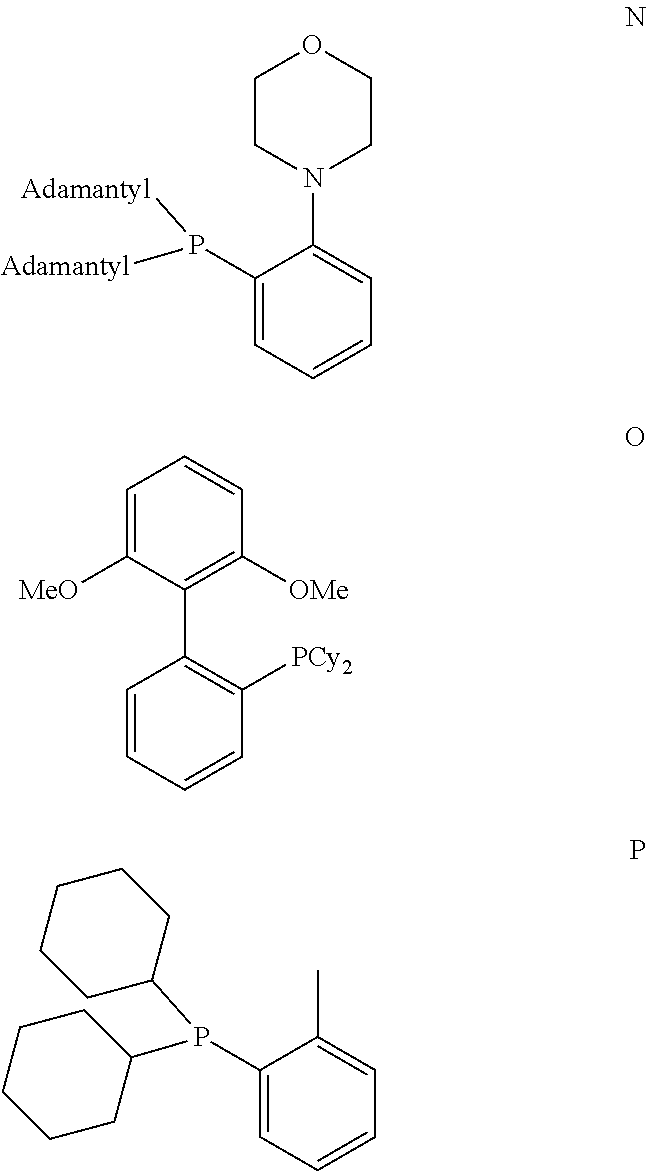
C00018

C00019

C00020

C00021

C00022

C00023

C00024
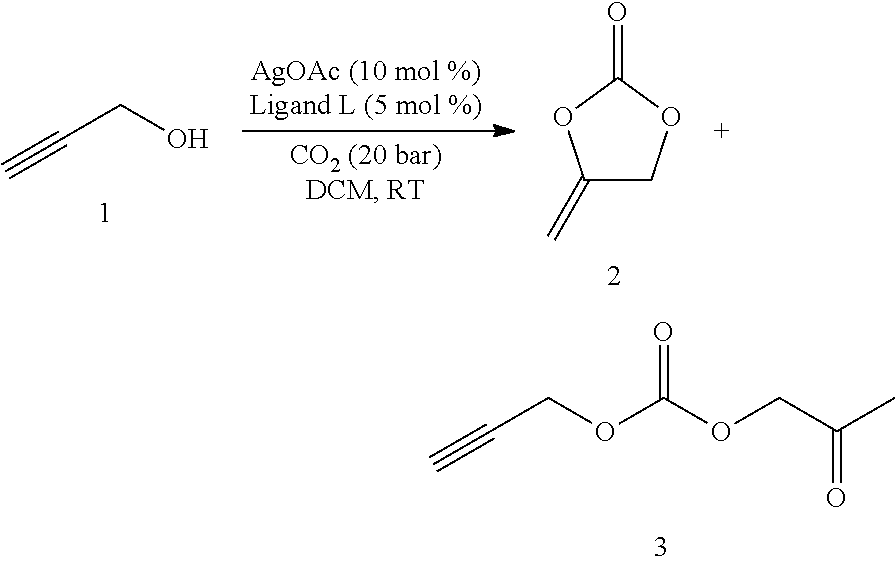
C00025

C00026

C00027

C00028
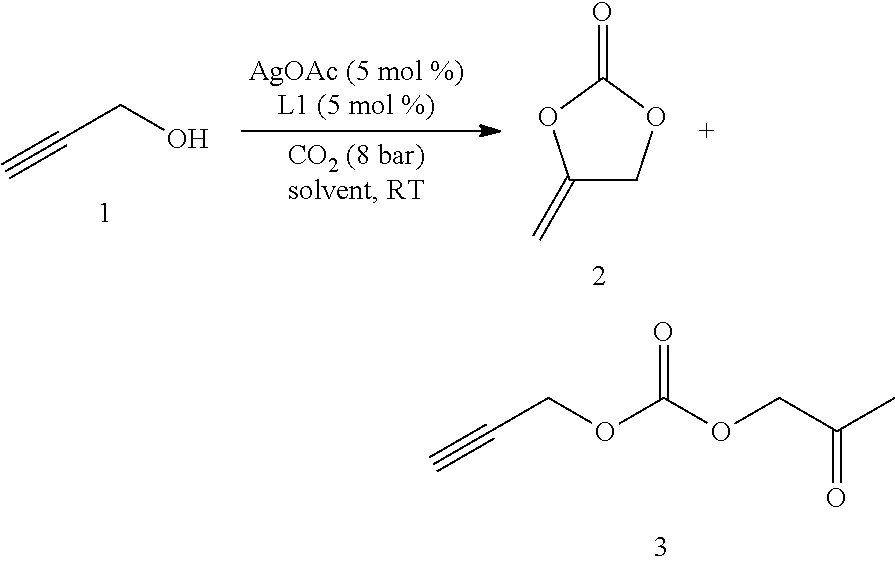
C00029
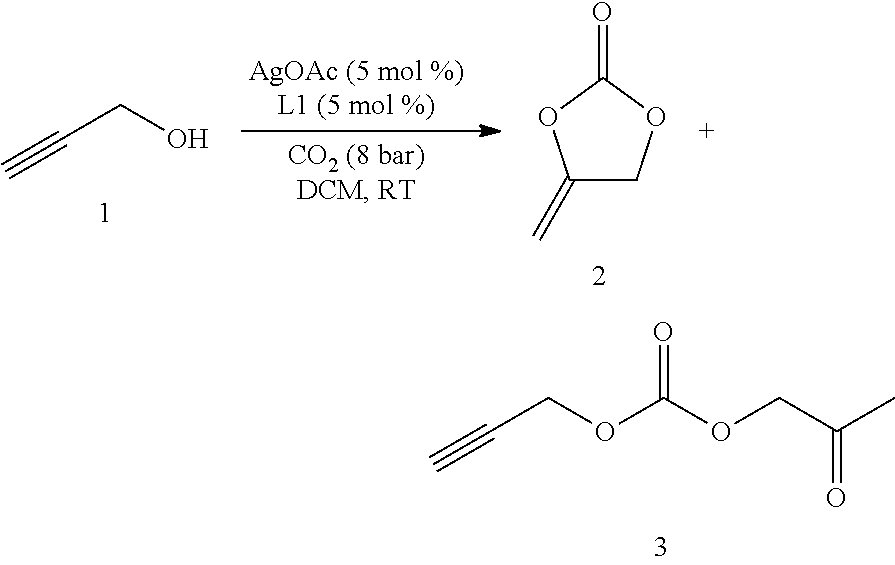
C00030

C00031

C00032
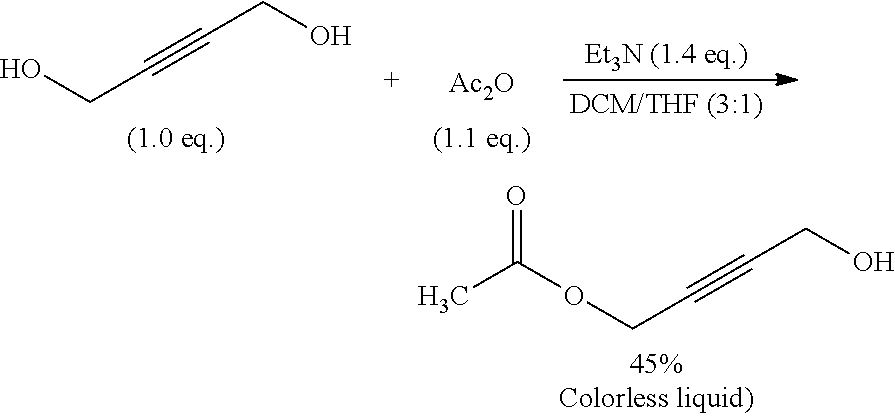
C00033

C00034

C00035
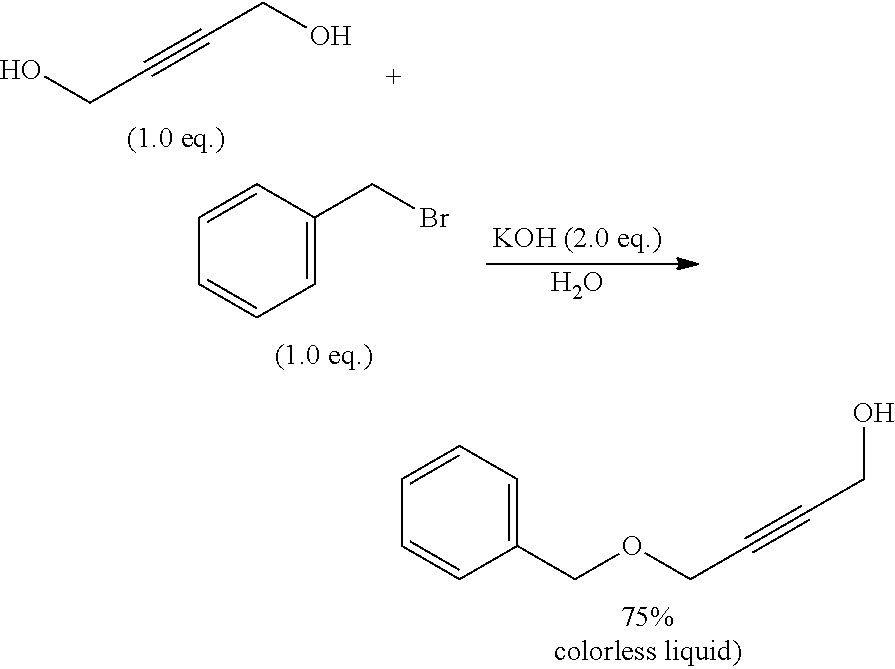
C00036

C00037

C00038

C00039
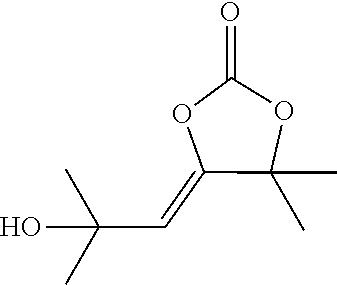
C00040
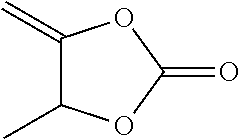
C00041

C00042
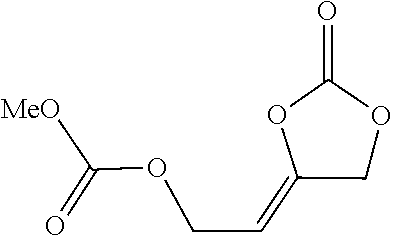
C00043

C00044
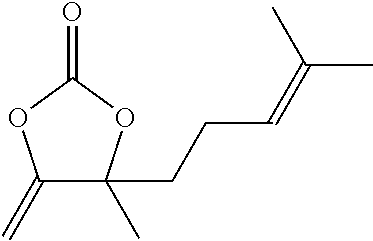
C00045

C00046

C00047

C00048

C00049

C00050

C00051
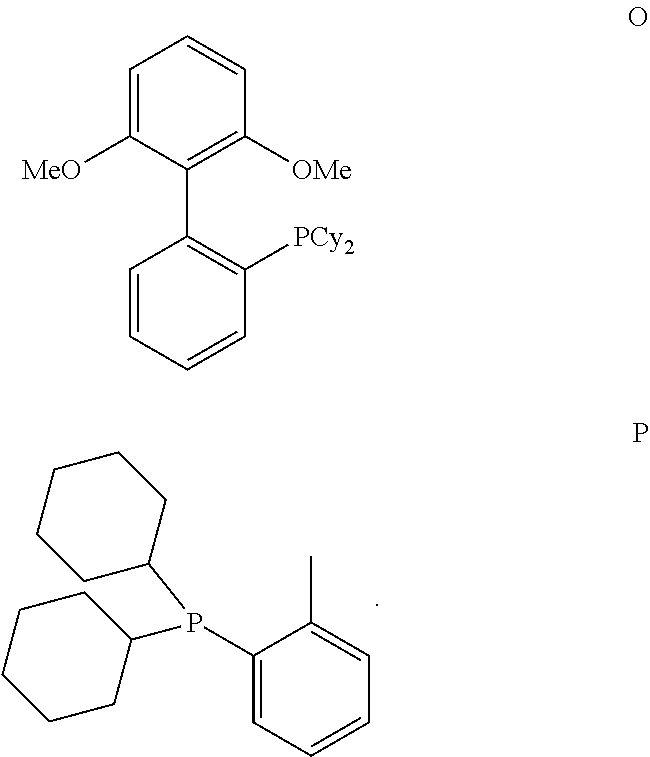
C00052
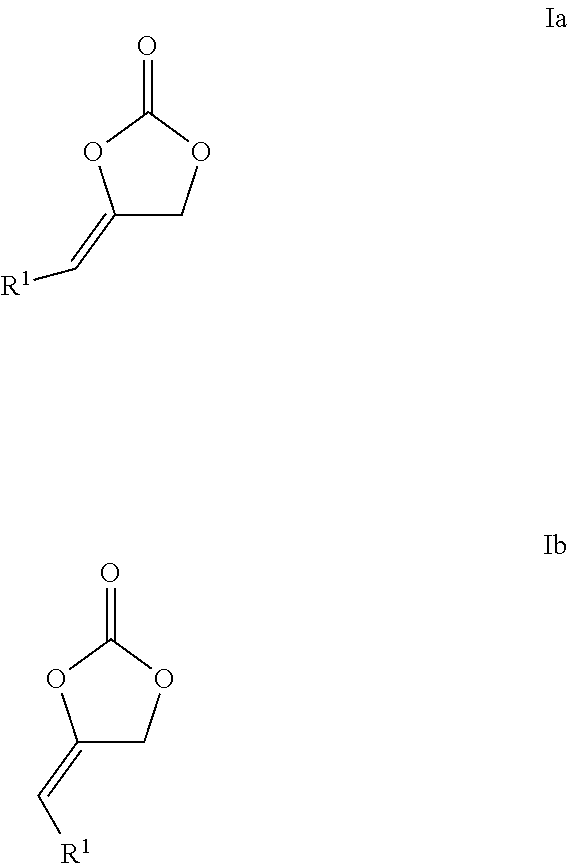
C00053

C00054
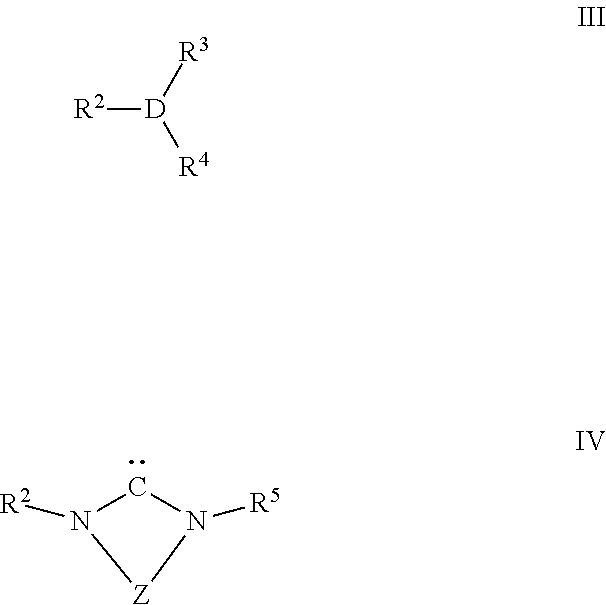
C00055

C00056
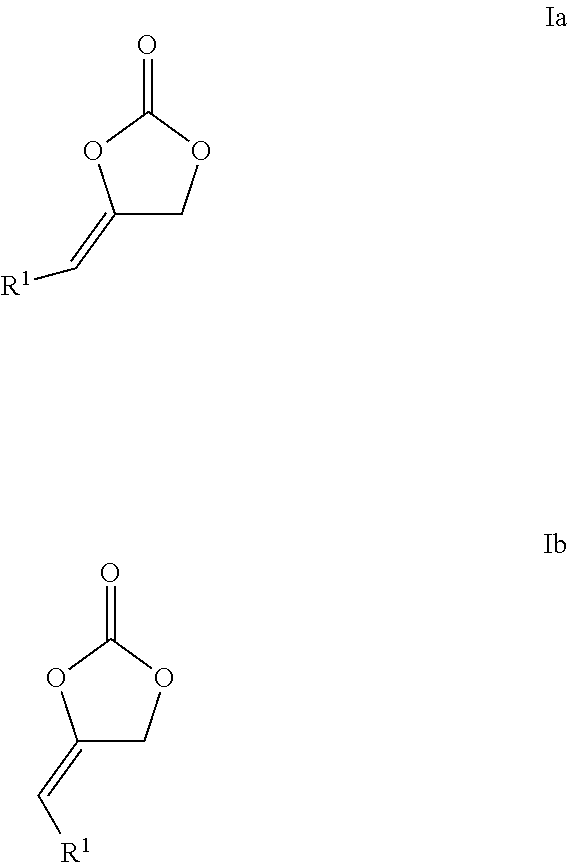
C00057

C00058

XML
uspto.report is an independent third-party trademark research tool that is not affiliated, endorsed, or sponsored by the United States Patent and Trademark Office (USPTO) or any other governmental organization. The information provided by uspto.report is based on publicly available data at the time of writing and is intended for informational purposes only.
While we strive to provide accurate and up-to-date information, we do not guarantee the accuracy, completeness, reliability, or suitability of the information displayed on this site. The use of this site is at your own risk. Any reliance you place on such information is therefore strictly at your own risk.
All official trademark data, including owner information, should be verified by visiting the official USPTO website at www.uspto.gov. This site is not intended to replace professional legal advice and should not be used as a substitute for consulting with a legal professional who is knowledgeable about trademark law.